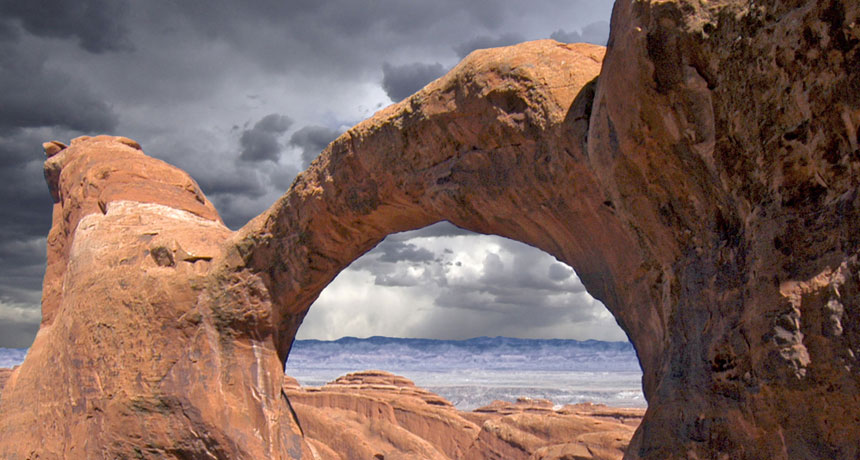Bracing sand sculptures with gravity
Gravity keeps giant sandstone arches and pillars from crumbling

Thanks to gravity, a new study finds, sandstone arches like this one don't crumble.
MICHAEL ATMAN
Gravity keeps things from flying off the planet. It also helps towering pillars and soaring arches of sand stand up to the weather, scientists now report.
Tiny grains of sand stick together to form a type of rock called sandstone. Over time, wind and rain chip away at the edges, carving large natural sculptures that resemble arches and pillars. Scientists have typically credited sandstone’s endurance to a chemical glue. It was supposed to hold the grains together. A study published July 21 in Nature Geoscience now challenges that explanation.
The study began when Jiří Bruthans was visiting a quarry. He’s a geologist at the Czech Republic’s Charles University in Prague. Bruthans noticed a funny thing about sandstone at the quarry. Workers had to use explosives to break apart big chunks of the stone. But small rocks quickly crumbled in his hand. Something didn’t add up.
Bruthans suspected some other force, not glue, was holding the sand together. So he gathered some scientists and started playing with the sand. They built sand cubes 10 centimeters (4 inches) on a side. Then they added 1-kilogram (2.2-pound) weights on top. Those weights simulated the downward force that would come from rocks stacked on top of sandstone. Then they put the cubes in water, allowing it to pick away at the edges, just as the weather might.
Over time, sides of the blocks eroded. Grains there had gradually fallen away. The process left an hourglass-shaped pillar that still held up the weight. And after a few minutes, the scientists found that the remaining pillars were even stronger than the original cube had been.
They concluded that as gravity pulled on those heavy weights, the downward force actually increased the sculpture’s resistance to erosion.
“The weight allows these formations to withstand what would be horrendous weathering processes,” such as rain and wind, Alan Mayo told Science News. A geologist at Brigham Young University in Provo, Utah, he worked with Bruthans on the project. “These things survive thousands of years in a harsh environment,” he notes.
Chris Paola, a geologist at the University of Minnesota in Minneapolis, wrote a short article about the experiment in the same issue of Nature Geoscience. He said the study gives clear evidence of a simple but interesting idea: “Bruthans and colleagues present nothing more or less than a lovely and elegant formative mechanism for a lovely and elegant kind of landform.”
Power Words
force Some outside influence that can change the motion of a body or produce motion or stress in a stationary body.
geology The study of Earth’s physical structure and substance, its history and the processes that act on it. People who work in this field are known as geologists. Planetary geology is the science of studying the same things about other planets.
gravity The force that attracts anything with mass, or bulk, toward any other thing with mass. The more mass that something has, the greater its gravity.
sandstone A type of sedimentary rock. It forms as sand-size grains of mineral grit become compacted or glued together over long time periods.







